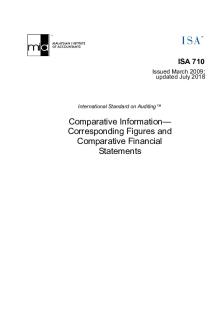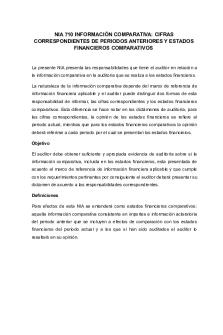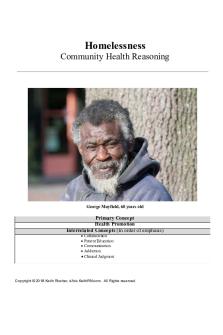Homeless - Karakter: 7-10 PDF

| Title | Homeless - Karakter: 7-10 |
|---|---|
| Course | Engelsk |
| Institution | Gymnasie (Danmark) |
| Pages | 2 |
| File Size | 86 KB |
| File Type | |
| Total Downloads | 25 |
| Total Views | 142 |
Summary
homeless...
Description
HOMELESS The short story “Homeless”, written by Ovo Adagha in 2008, narrates the childhood of the main character Nne who is living in poverty. Nne’s family is forced to move into a ghetto neighborhood, because her father lost his job. The story begins with the scene of Nne and her young brother Ebuka trudging without footwear on their way home in the midday sun. While Ebuka fervently explains what makes his uniform dirty to Nne and worries about being punished by his mother, Nne keeps an eye on Ebuka on the heavy traffic and tries to release her brother’s footsore by appeasing him. They come home in time to witness a horrible moment, which changes their lives forever. The neighborhood, including their shanty house is destroyed completely by bulldozers. Their mother is busy with collecting their belongings in grief and hopelessness. The story ends with the image of their mother in the rain while Nne and Ebuka sit on a bench in fear with the empty stomach. “Homeless” is the short story, where we meet the most impoverished people in the society of developing countries, thereby we are made aware of the importance of home for children. While reading this story we can identify that the physical setting is the slum, where gathers the weakest and poorest people in society, and where we can meet another life in developing countries. Moving to the temporal setting, we can see that the story can take place any country in the modern life. “Homeless” is told from the point of view of the protagonist named Nne. This means we only have access to the narrator’s thoughts and feelings on the events. From the beginning of the story, it is clear that Nne is an empathetic and caring girl. This is shown through the way she cares for her younger brother’s feelings and health. She does not have breakfast because she wants to save food for him. This is also shown in the following quotes “I knew from experience that his feet were hurting. (…) To distract him from his travails I spoke softly to him” (p.1 ll.31-33), or “… I had a strong matronly attachment towards him - maybe because I had been taking care of him since the day he was born” (p.2 l.38). We clearly see that their relationship is very special, because she looks like a young mother of her brother. Even though Nne is just 13 years old, she expresses herself much more mature than we would expect from someone of her age. Moreover, Nne is resilient. She is able to adapt to new environments. It is clear from the quote “But it was my home nonetheless, and there was nothing I could do about it - at least not while I was still in school. I lived for the day I would be able to start work and earn enough money to relocate my family to a more conductive environment.” (p.2 ll.64 - 66). By looking at this quote, one
feels that she knows how to adjust herself to fit into the new environment and lives with a strong belief in a better life in the future, even though she is ridiculed at school due to poverty. The noticeable detail in the story is when Nne sees her shanty house being destroyed. Her reaction is “I opened my mouth in a soundless scream as one of the rampaging bulldozers shoved our makeshift shack aside.” (p.3 l. 100). The protagonist at the first time manifests her weakness and disappointment, since the destruction of the house seems become the drop that makes a glass overflow. The title of the story “Homeless” gives us a lot of things to think about, because it is not only a homeless situation but also a feeling of despair and insecurity. Throughout the story, we can identify that one of the main themes as “The importance of home for children”. The poverty is one of the most discussed topics on media. The poverty is not only about material but also about mental. How can we help them to escape their struggled situation? Solving this issue requires an effort both from people and government. On the one hand, the government can help the poor through policies. The most important policy that one can provide is free education, because educational achievement is a key to a success and an escape from poverty. Besides that, housing support can be a solution for people who have too low incomes for housing, so that they can avoid homelessness. For example, Nne’s family becomes homeless because they do not receive any help from the government. Moreover, the government can help them with employment. Likewise, free healthcare service can also be a security net for the poor, as health is fundamental. On the other hand, we can personally help the poor by showing love and respect to them. In this way the poor do not feel isolated in our society, and they are aware that someone cares about them. For instance, Nne would not have felt upset if her schoolmates had respected her. Besides, we can help them economically, by donating to charity organizations. In conclusion, we should give a helping hand to the people in great poverty, because is it not only a common responsibility of the whole society, but also an act of humanity....
Similar Free PDFs

Homeless - Karakter: 7-10
- 2 Pages

CAFS Study Notes Homeless
- 10 Pages

CAFS groups in context - homeless
- 15 Pages

Standard Auditing 710
- 19 Pages

CAFS HSC Notes - Homeless People
- 12 Pages

Pendidikan karakter
- 33 Pages

Pengertian karakter
- 5 Pages

Pendidikan Karakter
- 22 Pages

ISA 710 - Lecture notes 3
- 19 Pages

PENDIDIKAN KARAKTER
- 8 Pages

Karakter manusia
- 13 Pages

Ensayo NIA 710 Y 720 del IMCP
- 12 Pages

Exercices courses pour le 710
- 3 Pages

Woodkids 300-710 Firepower dumps
- 35 Pages
Popular Institutions
- Tinajero National High School - Annex
- Politeknik Caltex Riau
- Yokohama City University
- SGT University
- University of Al-Qadisiyah
- Divine Word College of Vigan
- Techniek College Rotterdam
- Universidade de Santiago
- Universiti Teknologi MARA Cawangan Johor Kampus Pasir Gudang
- Poltekkes Kemenkes Yogyakarta
- Baguio City National High School
- Colegio san marcos
- preparatoria uno
- Centro de Bachillerato Tecnológico Industrial y de Servicios No. 107
- Dalian Maritime University
- Quang Trung Secondary School
- Colegio Tecnológico en Informática
- Corporación Regional de Educación Superior
- Grupo CEDVA
- Dar Al Uloom University
- Centro de Estudios Preuniversitarios de la Universidad Nacional de Ingeniería
- 上智大学
- Aakash International School, Nuna Majara
- San Felipe Neri Catholic School
- Kang Chiao International School - New Taipei City
- Misamis Occidental National High School
- Institución Educativa Escuela Normal Juan Ladrilleros
- Kolehiyo ng Pantukan
- Batanes State College
- Instituto Continental
- Sekolah Menengah Kejuruan Kesehatan Kaltara (Tarakan)
- Colegio de La Inmaculada Concepcion - Cebu

